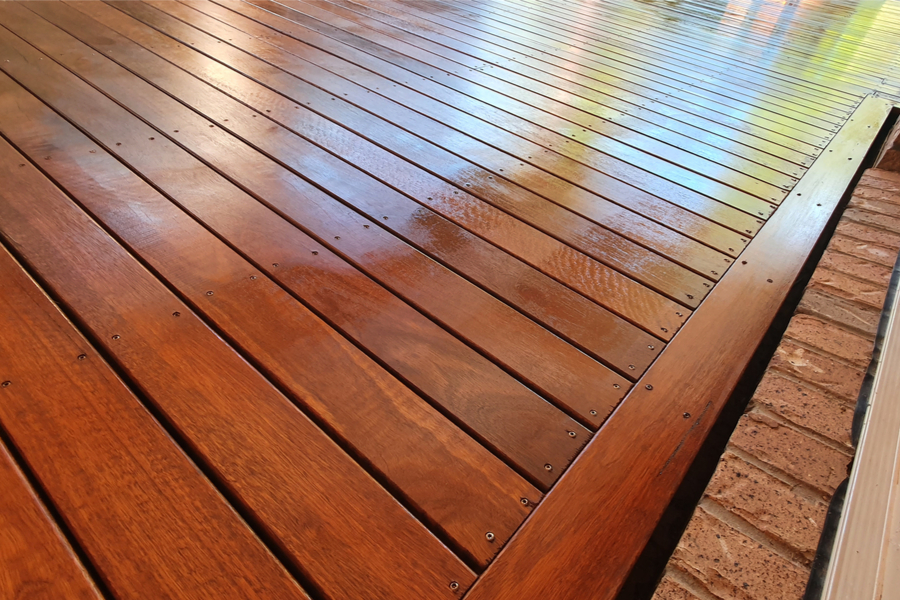Deck Staining Sparkle: Boost Your Outside Living Area
Deck Staining Sparkle: Boost Your Outside Living Area
Blog Article
Selecting the Right Stain for Your Fencing: Tips and Considerations
When it comes to boosting the look and keeping of your fence, selecting the appropriate stain is important. We will certainly explore the different types of fence stains, elements to take into consideration before choosing a stain, suggestions for preparing your fence for discoloration, and the distinctions in between oil-based and water-based stains. Furthermore, we will certainly delve into choosing the right stain color to complement your fence and boost your outside space.
Understanding Different Types of Fencing Spots

On the various other hand, water-based stains are made from acrylic or latex and use an extra refined color to the timber. They develop a protective film on the surface of the timber, protecting against moisture from seeping in and securing versus UV damages. Water-based spots are easier to tidy up and have a quicker drying out time contrasted to oil-based discolorations. They are also less likely to split or discolor with time.
Choosing in between oil-based and water-based spots relies on different factors, consisting of personal choice, the preferred look, and the level of maintenance needed. Oil-based spots are suggested for fences in high-traffic locations or those frequently revealed to severe weather condition problems. fence staining and sealing. Water-based stains, on the other hand, are a popular choice for fencings in suburbs where look and convenience of usage are crucial
When picking the ideal discolor for their fence,Recognizing the distinctions between water-based and oil-based spots assists homeowners make an informed choice. Thinking about the specific demands of the fencing, such as its area, exposure to sunshine, and preferred visual, will guarantee that the selected discolor supplies long-lasting defense and enhances the general charm of the fencing.
Aspects to Think About Prior To Choosing a Discoloration

Various types of wood absorb discolorations in different ways, resulting in varying degrees of color strength and sturdiness. Additionally, specific timbers may be extra susceptible to concerns like rot or insect invasion, which might affect the option of stain to shield and maintain the fencing.
The environment and weather in your area need to also be taken into account. You may need a stain that provides added defense versus dampness and UV rays if you live in a location with rough winters or high humidity. Furthermore, if your fencing is revealed to route sunshine for lengthy periods, a tarnish with UV preventions can aid protect against fading and staining.
Last but not least, it is essential to consider your preferred aesthetic. Different stains provide different colors and surfaces, enabling you to customize the look of your fence (deck staining). Think about the overall design and layout of your home, along with any kind of regional regulations or home owner organization guidelines that might determine the appropriate stain shades
Tips for Preparing Your Fencing for Staining
Cleaning the fencing is an essential action as it removes dust, crud, and any previous coatings that might interfere with the discoloration procedure. Scrub the surface delicately, paying extra interest to areas with persistent discolorations or mold.
After cleansing, enable the fencing to dry totally. deck staining. This step is critical as staining a damp or damp surface can bring about poor bond and an irregular finish. Depending upon the climate condition, it might take anywhere from a couple of hours to a few days for the fence to dry extensively. Make certain that the fence is totally dry before waging the discoloration procedure.
Before staining, examine the fence for any problems, such as loosened boards or nails. Fix any kind of concerns to make certain that the fencing is structurally audio. Furthermore, think about applying a wood conditioner or brightener to the surface. This item helps to open the wood pores, allowing the stain to penetrate more effectively and evenly.

Comparing Oil-Based and Water-Based Spots
When picking a stain for your fence, it is essential to compare the qualities and advantages of oil-based and water-based spots. Both kinds of stains have their own advantages and factors to consider, so it is important to recognize the differences between them.
Oil-based stains are understood for their resilience and resistance to tear and use. Furthermore, oil-based spots have a tendency to last longer than water-based spots, making them a preferred selection for fencings.
On the other hand, water-based discolorations are extra ecologically friendly and less complicated to clean up. They may not give the exact same level of defense as oil-based spots, particularly in harsh climate conditions.
Ultimately, the selection check my site in between water-based and oil-based spots depends on your details requirements and choices. When making your decision, consider factors such as durability, ecological impact, and convenience of application. Consulting with a professional or seeking referrals from specialists can likewise aid guarantee that you pick the best tarnish for your fence.
Selecting the Right Spot Color for Your Fencing
The option of a proper tarnish color for your fencing is an important facet of enhancing its aesthetic charm and enhancing the overall design of your outside area (fence staining). The best discolor shade can transform a plain, ordinary fence right into a striking centerpiece that includes depth and personality to your building
When selecting a tarnish color for your fencing, it is vital to think about the style and architecture of your home. If you have a traditional or typical style home, natural tones such as browns and neutrals can produce a cozy and welcoming look. On the other hand, if you have a contemporary or modern-day home, you might think about deciding for bold and lively shades that make a statement.
An additional factor to think about is the all-natural environments of your property. If you have a great deal of plant, a discolor color that matches the natural landscape, such as environment-friendlies or crimsons, can create a harmonious and cohesive appearance.
Additionally, it's worth considering the maintenance required for different discolor shades. Lighter shades often tend to show dirt and wear more easily, while darker colors can conceal blemishes and require much less frequent touch-ups.
Ultimately, the choice of discolor color for your fence ought to show your personal style and preferences - deck staining nashville tn. Take the time to consult and explore different choices with experts if required, to ensure that you choose the best tarnish shade that enhances the appeal and charm of your fencing
Verdict
In verdict, when it comes to picking the appropriate tarnish for your fence, it is essential to understand the various kinds of spots offered and think about elements such as sturdiness and preferred appearance. Picking the ideal discolor color can enhance the overall visual appeals of your fence.
We will certainly discover the different types of fencing spots, aspects to think about before choosing a tarnish, suggestions for preparing your fence for discoloration, and the distinctions between oil-based and water-based stains.Distinguishing in between oil-based and water-based stains is critical when comprehending different kinds of fencing spots. Water-based stains are less complicated to clean up and have a faster drying out time compared to oil-based discolorations. In addition, oil-based discolorations have a tendency to last longer than water-based discolorations, making them a prominent selection for fences.
In verdict, when it comes to picking the best tarnish for your fence, it is crucial to recognize the different types of discolorations available and take into consideration elements such as resilience and preferred look.
Report this page